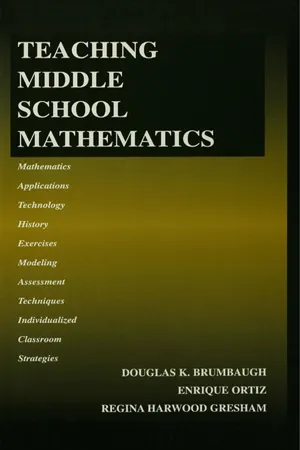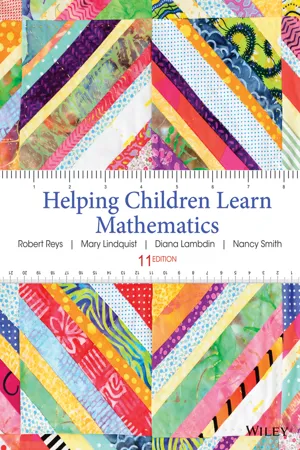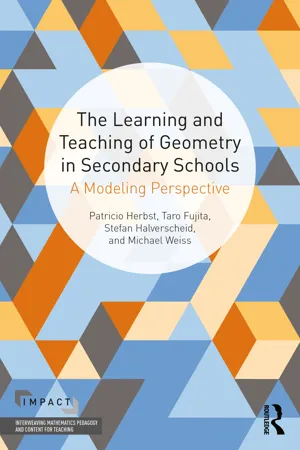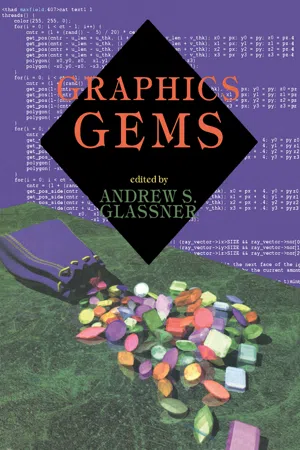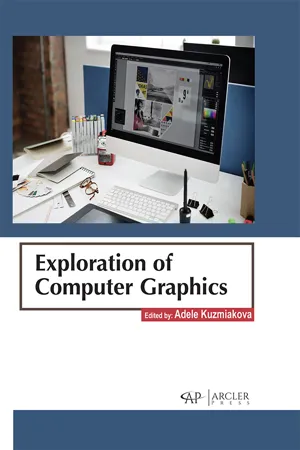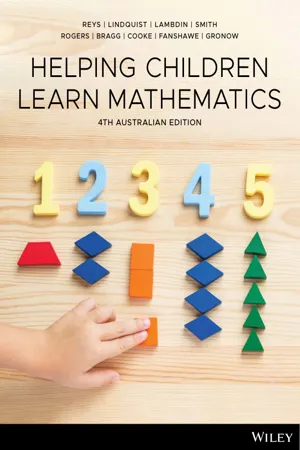Mathematics
2-Dimensional Figures
2-dimensional figures are shapes that exist in two dimensions, typically on a flat surface. They have length and width, but no depth. Common examples include squares, rectangles, circles, triangles, and polygons. These figures are fundamental to geometry and are used to study properties such as area, perimeter, and angles.
Written by Perlego with AI-assistance
Related key terms
1 of 5
10 Key excerpts on "2-Dimensional Figures"
- eBook - PDF
- James Arvo(Author)
- 2013(Publication Date)
- Morgan Kaufmann(Publisher)
2D GEOMETRY AND ALGORITHMS Two-dimensional geometry pervades computer graphics. For that reason, a graphics programmer requires tools for solving a wide variety of 2D geometrical problems efficiently. Solutions to several typical 2D problems are presented in this Part: computing the area of a planar figure, the distance from a point to a line, and finding the minimal enclosing area for some set of objects. Problems of this type arise partly because of the inherent two-dimen-sional nature of the screen or surface on which graphics output is displayed. Another reason 2D geometry is important is that larger prob-lems in three dimensions are frequently attacked by reducing them to smaller and simpler problems in one or two dimensions. This tactic of breaking a large problem into little palatable ones is perhaps nowhere more evident than in large computer programs. Graphics, in particular, tends to reduce ultimately to a large number of small 2D problems, increasing the importance of handling each one robustly and efficiently. The first six gems of this Part address some common 2D operations that can serve as basic building blocks for more complex tasks. The next two gems deal with generating and utilizing a class of space-filling curves. These curves are members of an infinite family of related curves that possess an interesting property: If the steps in their constructions are carried out a sufficiently large number of times, the resulting curves will come arbitrarily close to every point in some region of space. Although this concept is equally valid in spaces of any dimension, space-filling curves are most immediately useful and accessible for computer graphics 3 2D GEOMETRY AND ALGORITHMS when they are in two dimensions. For instance, their convoluted paths provide an interesting order in which to generate the pixels of an image, as described in Gem number 1.8. - eBook - PDF
Mathematical Literacy NQF2 SB
TVET FIRST
- K van Niekerk O Roberts(Author)
- 2017(Publication Date)
- Macmillan(Publisher)
Flat and three-dimensional shapes This module is all about flat shapes and three-dimensional objects. You will name shapes and objects and describe their properties. You will also use formulae to do calculations related to shapes and objects. You will use formulae and diagrams for solving space, shape and orientation problems. Unit 6.1 Names and properties of two- dimensional shapes It is very important that you are able to name and recognise two-dimensional shapes, and that you know the characteristics that make each shape special. If you know this, you will be able to work with the different shapes. Two-dimensional shapes Two-dimensional (2-D) shapes are flat shapes. This means that they have no thickness. The common shapes that you are going to study are shown here: You need to be able to describe the properties of squares, rectangles, triangles and circles in terms of their sides and angles. 103 Module 6 Two-dimensional shapes and three-dimensional objects Module 6 Learning Outcomes In this module, you will: • recognise and identify the following: ¢ shape: square; rectangle; triangle; circle ¢ space: block; cube; rectangular prism; cylinder ¢ attributes: length; breadth; height; side; base; perimeter; diagonal; area; angle; centre; radius; diameter; circumference; volume; perpendicular height; parallel lines. • determine the length of the hypotenuse of a right-angled triangle using the Theorem of Pythagoras • use given formulae and calculate the following: (use appropriate conversions and rounding off) ¢ perimeter/circumference: square; rectangle; triangle; circle ¢ area: square; rectangle; triangle; circle ¢ volume: cube; rectangle prism; cylinder. Subject Outcome 2.1: Acquire the correct vocabulary of space, shape and orientation. Subject Outcome 2.2: Perform space, shape and orientation calculations correctly to solve problems in personal and familiar contexts. - eBook - ePub
- Douglas K. Brumbaugh(Author)
- 2013(Publication Date)
- Routledge(Publisher)
Middle school students should have investigation opportunities that involve precisely describing, classifying, and understanding relationships among types of two- and three-dimensional objects (e.g., angles, triangles, quadrilaterals, cubes, and cones) and using the defining properties and similar attributes of these objects (including their angles, side lengths, perimeters, areas, and volumes; NCTM, 2000). This section provides some discussion and examples of this type of investigations, first using two-dimensional shapes and second using three-dimensional shapes. The investigations for two-dimensional shapes involve convex (interior angles are less than 180°) and concave (nonconvex) polygons. Polygons are named according to the number of sides (quadrilateral [4], pentagon [5], hexagon [6], and so on, or n-gon in general, where n represents the number of sides of the polygon). The following are some possible activities involving two-dimensional figures.Your Turn12.16. Ask middle school students to make different triangles on a geoboard using rubber bands and then draw a picture of their triangle on dot paper (see Fig. 12.12 ), describing each triangle, incorporating precise geometric language (equilateral, isosceles, scalene, acute, right, or obtuse). (This activity involves van Hiele levels 0, 1, and 2.)Fig 12.12.12.17. Ask middle school students to make different squares on a geoboard and sketch them on dot paper (see Fig. 12.12 ). Ask them to find as many squares as possible (limited to a 5-pin by 5-pin section of the geoboard) and to answer the following questions:How many squares did you find? How do you know if you have found all possible squares?(This activity involves van Hiele levels 0, 1, and 2.) 12.18. Ask middle school students to find as many different rectangles as possible on a geoboard (limited to a 5-pin by 5-pin section of the geoboard). (This activity involves van Hiele level 3.)Two-dimensional shapes can also be investigated using transformational geometry. Transformational geometry could be used to describe sizes, positions, and orientation of shapes through flips, turns, slides, and scaling, also including examination of the congruence, similarity, and line or rotational symmetry of objects (NCTM, 2000).Translations, rotations, reflections, and glide reflections preserve shape and size and can create images that have symmetry. Compare your left hand with your right hand. They are an approximate (we know there are slight differences in the hands) example of symmetry created by reflection. For translation or sliding symmetry, consider a wallpaper pattern that repeats. Cut out a piece of the wallpaper and slide it up or down. It matches a new section exactly. Rotation or turning symmetry can be seen on fancy car wheels. We recommend that you read about the work of M. C. Escher and review some of his famous images using transformations. (Information can be found at http://www.mcescher.com - eBook - PDF
- Robert Reys, Mary Lindquist, Diana V. Lambdin, Nancy L. Smith(Authors)
- 2014(Publication Date)
- Wiley(Publisher)
OTHER ATTRIBUTES We have touched on the most common attributes, but there are several other attributes that may be used in describing two-dimensional shapes. PIEZLES (PIECE PUZZLES) Objective: To build two-dimensional shapes with parallel sides. Grade Level: 4–5. Materials: Pattern blocks. • Solve these piezles (puzzles) using pattern blocks. Draw a sketch of the shape you made. 1. Use two different pieces: make a shape with • Exactly 2 pairs of parallel sides • Exactly 1 pair of parallel sides • No parallel sides 2. Use three different pieces; make a shape with • Exactly 3 pairs of parallel sides • Exactly 2 pairs of parallel sides • Exactly 1 pair of parallel sides • No parallel sides 3. What is the largest number of pairs of parallel sides of a shape you can make from • 2 pieces • 3 pieces • 4 pieces 4. Can you put all the pieces together to make a shape with no parallel sides? In the Classroom 15–10 See if children can describe a closed or open figure. Often they will describe an open figure as, “someone left the door open” or a closed figure as “to get inside, you have to go over as side.” Convex and concave Often children are exposed only to convex shapes (any polygon with all angles less than 180 degrees). Many of the activities suggested thus far have included concave shapes. When children are making shapes, concave examples will often give interesting variety. A B Two-Dimensional Shapes 315 measuring the altitude is essential in finding the area of geometric figures. In the Classroom 15–11 is designed to help children realize that a geometric object has different heights, or altitudes. After students do this with the triangu- lar model, have them draw a triangle on paper and again measure each side and each altitude. Classification schemes What makes a parallelogram a par- allelogram? When is a rhombus a square? What is a regular polygon? When students begin to understand the defining attributes of two-dimensional shapes, they are moving into Level 3. - eBook - ePub
- Sylvia Turner, Judith McCulloch(Authors)
- 2017(Publication Date)
- Routledge(Publisher)
Subject knowledge to teach properties of shape can be divided into three broad areas: 2D shapes, 3D shapes and constructions including nets of shapes. You may find that you have forgotten much of the terminology associated with shape. The specific language used enables shapes to be classified into categories and the process of classification helps us make sense of our experiences. The skills practised through classifying shapes can help children to classify numbers according to their properties. Teachers have to make this connection for children.2D shapes
We can classify 2D shapes according to whether their sides are straight or curved. Those with curved sides are generally familiar to children - a circle (e.g. the face of a clock) and a semicircle are the main plane shapes with curved sides that children will consider at primary level. An oval or ellipse is a familiar shape to children from their writing of the letter ‘o’ and the symbol for zero, but its mathematical properties are not considered at this stage.A 2D straight-sided closed shape is called a polygon . Polygons can be classified according to:• the number of sides of the polygon - triangles three sides, quadrilaterals four sides, pentagons five sides etc.;• regularity - polygons can be regular or irregular. They are regular when all the sides are the same length and all the angles the same size.Further classification is possible of triangles and quadrilaterals. Triangles can be classified according to their sides - equilateral (all sides equal length), isosceles (two sides equal length), scalene (no equal sides). Also, we consider their angles - acute (less than 90 degrees), obtuse (more than 90 degrees), right-angled (90 degrees), reflex (more than 180 degrees).Similarly, quadrilaterals can be classified into those that have parallel sides and those that do not. The majority of the quadrilaterals we use have at least one pair of parallel sides. A further refinement of definition could separate out those quadrilaterals into those with no parallel sides, those with one pair of parallel sides and those with two pairs of parallel sides, known as parallelograms. These parallelograms can then be further subdivided through the additional definition of whether or not they have internal right angles and/or whether or not any of their sides are of equal length. - eBook - ePub
The Learning and Teaching of Geometry in Secondary Schools
A Modeling Perspective
- Pat Herbst, Taro Fujita, Stefan Halverscheid, Michael Weiss(Authors)
- 2017(Publication Date)
- Routledge(Publisher)
p.48 2 GEOMETRIC FIGURES AND THEIR REPRESENTATIONS 2.1. IntroductionThe notion of geometric figure, while defined loosely as well as restrictedly by Euclid (“14. A figure is that which is contained by any boundary or boundaries”, Euclid, 1956, p. 153), is central to Euclid’s Elements : Postulates enable possible figure constructions, and propositions assert properties of those figures or demonstrate that other figures can be constructed. Later expositions of geometric knowledge have varied in the extent to which they center on the notion of figure, with modern treatises either making figure a centerpiece as an application of set theory (“by figure we mean a set of points”, Moise, 1974, p. 37) or making figure a derived notion within a more general consideration of geometry as the study of transformations of space onto itself (see for example Guggenheimer, 1967; see also Jones, 2002; Usiskin, 1974).The notion of figure has also played a crucial role in scholarship on the teaching and learning of geometry (e.g., Duval, 1995; Fischbein, 1993). This chapter considers how scholarship from various disciplines has influenced our community’s thinking about geometric figures. It brings perspectives from mathematics and mathematicians, from the history and philosophy of mathematics, from cognitive science and semiotics, from technology and from mathematics education proper. Influenced by those perspectives we elaborate on the role of the geometric figure in geometry teaching and learning.We articulate some conceptions of figure related to its various representations in the context of making a curricular proposal on which to found research and development: To conceptualize the study of geometry in secondary schools as a process of coming to know figures as mathematical models of the experiential world. By this we mean that the study of geometry in secondary school could be seen as the development and use of conceptions of figure for students to make a particular kind of sense of their experiences with space and shape in the world: A sense-making akin to that of an applied mathematician creating a model of a real world phenomenon. This assertion clearly is not meant as a statement of fact—we have not ascertained that such a position is articulated by a majority of curricular offerings in geometry. Nor do we intend it prescriptively or ideologically, as a statement of how we think curriculum ought to be designed. Rather, the assertion is meant as the proposition of a perspective from which to read existing research: If the study of geometry were to be conceived of in that way, what would the existing research have to say about it? The assertion is also intended as the proposal of a large design research project within which to ask further research questions: If the study of geometry could be conceived of in that way, what could it look like, what could it make possible as far as students’ thinking and learning, what knowledge might it require of teachers, and what demands and tensions might it pose for teachers? - eBook - PDF
- Andrew S. Glassner(Author)
- 2013(Publication Date)
- Morgan Kaufmann(Publisher)
2D GEOMETRY This page intentionally left blank USEFUL 2D GEOMETRY Andrew S. Glassner Xerox PARC Polo Alto, California Many of the formulae in this section are 2D specializations of a more general solution. Why don't we bother giving the multidimensional solu-tion in its full generality? There are at least two good reasons that the equations in this section are mostly valid only in 2D: they either produce a unique answer, or they require less computation. These advantages are usually related to the facts that in 2D Euclidean geometry, nonparallel lines intersect and there is exactly one line perpendicular to a given line. Some of these formulae are valid in higher dimensions, and are re-peated in the Gem on Useful 3D Geometry without much change in the notation. Others are generalized in that Gem, when appropriate. I will use a programmer's notation to express the formulae. This allows us to express some computations in terms of previous results. I use the prefix V2 to distinguish the techniques for 2D vector geometry in this section from techniques with similar names in the 3D section. In this section the dot (or inner or scalar) product of two vectors A and B will be written A · B; this may be translated for implementation as V2 Dot(A, B). I will sometimes treat points as vectors; this will be allowed with the understanding that a point P will represent a vector P with tail at the origin and head at P; thus, the coordinate descriptions of both entities will have the same values. Record Line: [ implicit: N, c; Points P satisfy N · P + c = 0 (see Fig. la) explicit: U, V; Points P satisfy P = U + Vi for some scalar t (see Fig. lb) normalized: BOOL «- FALSE True if and only if |N| = |V| = 1 3 GRAPHICS GEMS * · (0, 0) Line structures of this form will be represented in italic (e.g., £, ra). Record Circle: [ center: C; radius: r ] Circles of this form will be represented by capital roman letters (e.g., A, B) (see Fig. 2). Figure 2. Figure 3. 4 Figure I. - eBook - PDF
- Adele Kuzmiakova(Author)
- 2023(Publication Date)
- Arcler Press(Publisher)
TWO-DIMENSIONAL COMPUTER GRAPHICS 2 CONTENTS 2.1. Introduction ...................................................................................... 38 2.2. Pixels, Coordinates, and Colors ........................................................ 38 2.3. Shapes .............................................................................................. 46 2.4. Transforms ........................................................................................ 52 2.5. Hierarchical Modeling ...................................................................... 58 2.6. Java Graphics2d................................................................................ 63 References ............................................................................................... 67 CHAPTER Exploration of Computer Graphics 38 2.1. INTRODUCTION Here, we start our studies of computer graphics by focusing on a two- dimensional example. Computer graphics concepts are easier and simpler to understand in a 2D environment rather than in a 3D setting. However, the majority of the concepts taught in this section are equally applicable in 3D. The chapter begins with four components that look at 2D graphics broadly, without focusing on a specific computer program or visuals API (Reichenbach et al., 2004). The programming samples in such parts are presented in pseudocode, which should become intelligible to anybody studying this book which has some coding skills. We’ll examine 2D graphics in three different languages in the following three parts: Java with Graphics2D, JavaScript using HTML - eBook - PDF
Mathematics for Elementary Teachers
A Contemporary Approach
- Gary L. Musser, Blake E. Peterson, William F. Burger(Authors)
- 2013(Publication Date)
- Wiley(Publisher)
Describe attributes and parts of two- and three-dimensional shapes. Recognize and create shapes that have symmetry. Recognize and represent shapes from different perspectives. GRADES 3-5–GEOMETRY Identify, compare, and analyze attributes of two- and three-dimensional shapes and develop vocabulary to describe the attributes. Classify two- and three-dimensional shapes according to their properties and develop definitions of classes of shapes such as triangles and pyramids. GRADES 6-8–GEOMETRY Precisely describe, classify, and understand relationships among types of two- and three-dimensional objects using their defining properties. Use two-dimensional representations of three-dimensional objects to visualize problems. Key Concepts from the NCTM Curriculum Focal Points PRE-K-2: Identifying shapes and describing spatial relationships. KINDERGARTEN: Describing shapes and space. GRADE 1: Composing and decomposing geometric shapes. GRADE 3: Describing and analyzing properties of two-dimensional shapes. GRADE 5: Describing three-dimensional shapes and analyzing their properties, including volume and surface area. GRADE 8: Analyzing two- and three-dimensional space and figures by using distance and angle. Key Concepts from the Common Core State Standards for Mathematics KINDERGARTEN: Identify and describe two- and three-dimensional shapes (squares, circles, triangles, rect- angles, hexagons, cubes, cones, cylinders, and spheres). Analyze, compare, create and compose two- and three-dimensional shapes GRADE 1: Reason with two- and three-dimensional shapes and their attributes (defining and non-defining) GRADE 2: Reason with two- and three-dimensional shapes and use their attributes (defining) to draw shapes. GRADE 3: Reason with two-dimensional shapes across different categories (e.g., rhombuses, rectangles, and quad- rilaterals) and their attributes. GRADE 4: Draw and identify lines and angles, and classify shapes by properties of their lines and angles. - eBook - PDF
- Robert Reys, Mary Lindquist, Diana V. Lambdin, Nancy L. Smith, Anna Rogers, Audrey Cooke, Bronwyn Ewing, Kylie Robson(Authors)
- 2021(Publication Date)
- Wiley(Publisher)
Finally, children are asked to draw a four-sided shape that is neither a rectangle nor a square in each 2 × 2 grid. The educator is to look for the following criteria, as an example: 1. children’s ability to see and record different examples and non-examples of shapes in various sizes and orientations 2. children’s ability to identify shapes that illustrate given properties rather than simply identifying properties in shapes 3. children’s ability to differentiate shapes within other shapes. IN THE CLASSROOM 16.13 Can you fnd it? Objective: Recognise and shade polygons with given properties. Year level: 4–7 See if you can fnd each of the following shapes in the mosaic grid design. Fill in the shape and mark it with the matching letter. A: an isosceles triangle B: a scalene triangle C: a non-symmetrical quadrilateral D: a quadrilateral with four lines of symmetry E: a concave pentagon F: a convex pentagon G: a hexagon with exactly two pairs of parallel sides H: a symmetrical hexagon I: a non symmetrical heptagon (seven-sided shape) J: octagon Pdf_Folio:568 568 Helping children learn mathematics Extension: create a shape of your own, describe it and challenge a friend to fnd it on the design paper. 16.2 Location, position and spatial relationships LEARNING OUTCOME 16.2 Describing the roles that location, position and spatial relationships play in geometry. Within the content strand of Measurement and Geometry in the Australian Curriculum, the areas of two- dimensional shapes and three-dimensional objects are just one of the four sub-strands. Another significant part of geometry deals with location, movement, maps and pathways, and describe direction, distance and position. This is a very language-rich sub-strand that connects closely to children’s real world.
Index pages curate the most relevant extracts from our library of academic textbooks. They’ve been created using an in-house natural language model (NLM), each adding context and meaning to key research topics.


